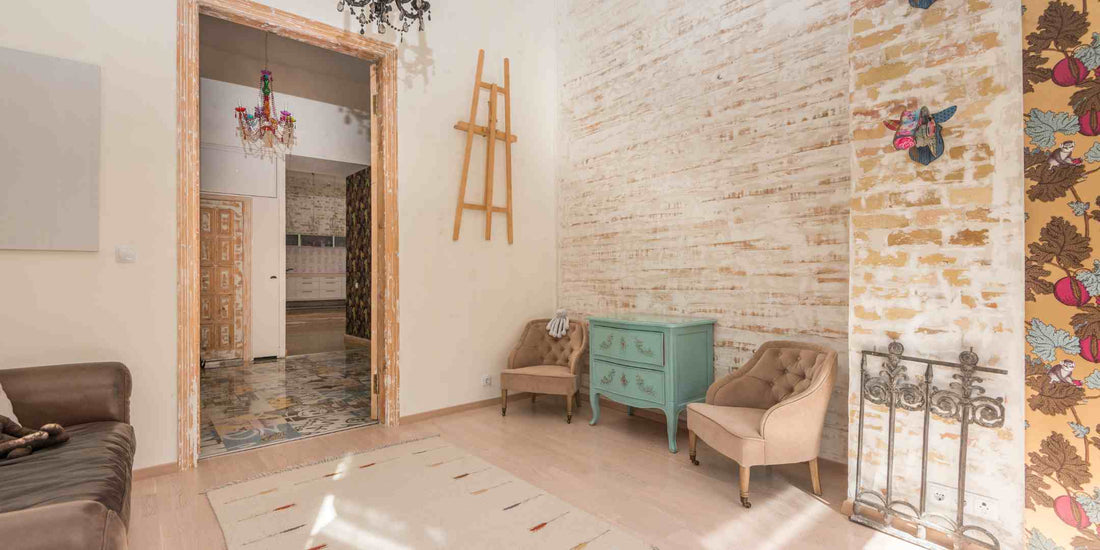
How to Mix and Match Patterns Without Overwhelming the Space
Share
Pattern mixing can make a room sing with layered harmony or clash like a bad outfit on laundry day. The trick? Balance, rhythm, and a little bravery.
If you're wondering how to mix patterns in a room without giving yourself a headache, here's your roadmap. It's practical and playful because your home deserves personality and polish.
Start With a Hero Pattern

Every room needs a main character. Choose one dominant pattern, such as a bold floral, a geometric print, a large-scale plaid, or anything that truly speaks to you. This pattern will set the tone for the rest of your decor. Think of it as your visual anchor. Everything else will orbit around it.
Large-scale patterns are easier to mix because they allow smaller, secondary designs to shine without competing.
Layer in Supporting Cast Members
Once you have your hero, it's time to layer in supporting patterns. This is where the magic (or mess) happens. The rule for mixing patterns is to vary the scale.
- Large-scale floral? Pair it with a tiny polka dot.
- Medium-sized stripes? Throw in some delicate herringbone or micro-checks.
When you mix patterns that look good together, the scale contrast keeps it from feeling chaotic. Similar-sized patterns tend to fight for attention.
Stick to a Cohesive Color Palette
This might be the most crucial rule in the pattern-mixing playbook. You can throw stripes, ikat, and animal prints in the same room and still end up in a harmonious space, as long as they speak the same color language.
Pick 2 to 3 primary colors, then allow one or two accent tones to add depth.
Use Solids as a Visual Breather
When mixing patterns and interior design styles, you'll need a pause. Solids are like commas in your design sentence. They break up the visual busyness and allow the eye to rest.
Use solid-colored upholstery, rugs, or curtains to calm down a space that might be pattern-heavy elsewhere.
Texture Counts as a Pattern, Too
We don't talk about this enough. Texture. Think bouclé, linen, velvet, cane, or rattan. It adds subtle layers and can serve as a pattern without visually overwhelming the space.
A neutral jute rug, for example, might not have a printed pattern, but its woven texture can still add depth to a patterned room.
Go Odd (Numbers, That Is)
When pairing patterns, work in odd numbers: three or five is usually the sweet spot. Too few, and the room feels incomplete. There are too many, and your guests might need sunglasses.
And remember, placement matters! Don't cluster all your patterns on one side of the room. Distribute them evenly for balance.
What Patterns Do Not Go Together?
This question comes up all the time. Technically, anything can work if scale and color are in harmony. But here's a cheat sheet of patterns that usually need extra care:
- Similar scale + high contrast color: This can feel dizzying.
- Too many busy prints without breathing room: Hello, chaos.
- Clashing themes: Like pairing tropical palms with rustic gingham.
But hey, design rules are meant to be bent. Just bend them intentionally.
Try the 60-30-10 Rule (Yes, It Works Here Too)
You may know this rule from color palettes, but it works beautifully for patterns, too:
- 60% dominant pattern
- 30% secondary/supporting pattern
- 10% accent pattern (or wild card)
This rule keeps everything feeling intentional. Think floral wallpaper (60), striped cushions (30), and a pop of animal print on a throw pillow (10).
Where to Begin if You're Nervous
If you're still unsure how to mix patterns in a room, start small:
- Throw pillows are your best friends
- Try mixing just two patterns
- Stick with black and white if colors scare you
Even experts had to start somewhere. And if something feels off, take a step back, remove one element, and breathe.
Final Thoughts

Pattern mixing is not about getting it perfect. It's about expression and energy. A home with personality and curated pattern play feels more like you.
So, go on. Layer that toile with those stripes. Your space can handle it.
Bonus Tip: Mix Materials Too
Do you mix velvet with rattan, leather with linen, or cane with ceramic? These material combinations add depth, like patterns, keeping your home from feeling one-note.
Mixing patterns in interior design styles is easier (and more fun) than you think.
Be brave. Be bold. But also, be balanced.
